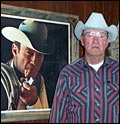You only live once unless you're larger-than-life. Three secular, larger-than-life icons are Bond, James "You Only Live Twice
About.com's Lisa Fayed explains:
IMAGES and captions courtesy of Wayne McLaren - Wikipedia contributor Plenz: (1) Wayne.McLaren.healthy: "As the Marlboro Man, promoting an 'independent lifestyle' in 1976." (2) Wayne.McLaren.sick: "Lying there with all those tubes in you, how independent can you really be?"Q: Did the Marlboro Man Die of Lung Cancer?
A: The answer is yes. The stetson wearing, rugged face of Marlboro did in fact die of lung cancer, not just once, but twice.
Many men played the role of the Marlboro Man throughout the years and two of these men died of lung cancer.
The first Marlboro Man to die of lung cancer was Wayne McClaren [sic] in 1992. He appeared in ads for Marlboro in 1976. He spent many years after his lung cancer diagnosis promoting an anti-smoking campaign.
The second Marlboro Man to pass of lung cancer was David McClean [sic], who succumbed to lung cancer in 1995. His family filed a suit against Phillip Morris [sic], citing he had to smoke sometimes five packs of cigarettes a day in order to complete commercial filming and print ad shoots.
The lawsuit also contended that Philip Morris gave McLean cartons of Marlboro cigarettes as gifts. Read more details about Marlboro Men, the lawsuit and the lives of McLaren and McLean at Snopes.com - Marlboro Manslaughter.
Wikipedia reports: "A fictitious version of this ironic situation was featured in the comic novel Thank You For Smoking: A Novel" and "A movie
based on the novel was released in 2006. While the characters are essentially the same, the plot differs substantially."
Bottom line: the Marlboro Men and other iconic smokers may be larger than life, but the real people who play and emulate them are not. Read about other celebrities who have died of lung cancer.
Compare these pictures from tobacco.com and their respective captions. Their juxtaposition recalls the 23 Psalm: "He maketh me to lie down in green pastures [...]. Yea, though I walk through the Valley of the shadow of Death[...]."


'Nuff said? Apparently not. Monica A. Doyle posted the following, favorable review of Marlboro Red cigarettes in a dooyoo.co.uk post entitled,"Cowboy Killers":
I know alot [sic] of people say they are a strong cigarette and that is why they got that nickname. But for me it is what I first started to smoke and always will smoke. The have just the right taste and flavor and are smooth as well. Atleast [sic] with Reds I know the quality of the cigarette not like with some of those cheap brands. Where you are diffently [sic] not getting what you pay for even if it is cheaper.Dooyoo members gave Monica's review five stars and rated it "somewhat useful," "useful" and "very useful."
Useful for what? Brrr. That review and its ratings chill my blood.
Ad Age Advertising Century: Icons: The Marlboro Man addresses these cold realities:
Even with the release in 1957 of the first article in Reader's Digest linking lung cancer to smoking[*] the real men of the Marlboro ads kept ringing up sales ($20 billion that year), attracting new smokers of both genders. In 1964, they revived the cowboy but this time he was in mythical Marlboro Country. This vivid image paid off in 1971 when cigarette ads were banned from TV.
The striking print shot of cowboys enjoying a smoke on horseback continued to fuel sales growth. In 1972, Marlboro became the No. 1 tobacco brand in the world.
As the anti-smoking movement has spread, the Marlboro Man has come under particular attack for his role in luring new customers to a cancer-causing habit.
You can find Marlboro, Marlboro Country, and other classic tobacco company ads here.
I hope stories like those of Wayne McLaren, David McLean and my father [Robert S. ("Bob") Tolliver] - a smoker who contracted emphysema and died last year of lung cancer - will make some smokers kick the habit and others butt out before they start. There's a reason why cigarettes are called "cancer sticks," "death sticks" and "cowboy killers." Wayne McLaren's before and after pictures tell the tale.
Two other prominent smokers who light up the list are childrens' favorites. #4, Santa Claus (Saint Nick), smokes a corncob pipe. #78 is Joe Camel.
 This real-life icon is a more suitable role model. In the photo to the left (from Kathleen Schalch's NPR report: "The Marlboro Man: Present at the Creation") Montana rancher Herf Ingersoll poses beside a 1970s Marlboro ad he modelled for. He's come a long way, baby. Thirty years after lending his face (soul?) to the world's best-selling cigarette brand, Herf - who has given up smoking - is still standing tall. Photo: Jackie Yamanaka.
This real-life icon is a more suitable role model. In the photo to the left (from Kathleen Schalch's NPR report: "The Marlboro Man: Present at the Creation") Montana rancher Herf Ingersoll poses beside a 1970s Marlboro ad he modelled for. He's come a long way, baby. Thirty years after lending his face (soul?) to the world's best-selling cigarette brand, Herf - who has given up smoking - is still standing tall. Photo: Jackie Yamanaka.







